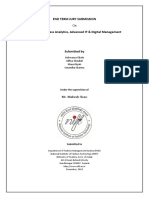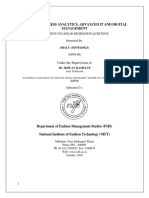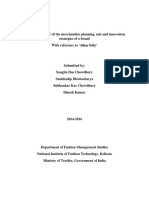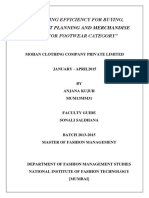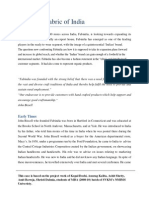0 ratings0% found this document useful (0 votes)
219 viewsSTC
STC
Uploaded by
Supriya PoteThe document summarizes the author's experience in a 22-day exchange program at the Swiss Textile College. Some key points:
- The author learned practical skills like tailoring techniques and management subjects. She was assigned a project on designing an Indian home textiles brand for the European market.
- The program covered topics like global fashion trends, brand management strategies, innovative materials and design tools. Excursions included visiting textile companies like Hugo Boss and ODLO Sportwear.
- The author gained an international perspective on the textile industry and received a certificate with 8 credit points upon completing the program.
Copyright:
© All Rights Reserved
Available Formats
Download as PDF, TXT or read online from Scribd
STC
STC
Uploaded by
Supriya Pote0 ratings0% found this document useful (0 votes)
219 views19 pagesThe document summarizes the author's experience in a 22-day exchange program at the Swiss Textile College. Some key points:
- The author learned practical skills like tailoring techniques and management subjects. She was assigned a project on designing an Indian home textiles brand for the European market.
- The program covered topics like global fashion trends, brand management strategies, innovative materials and design tools. Excursions included visiting textile companies like Hugo Boss and ODLO Sportwear.
- The author gained an international perspective on the textile industry and received a certificate with 8 credit points upon completing the program.
Original Description:
work in swiss
Original Title
Stc
Copyright
© © All Rights Reserved
Available Formats
PDF, TXT or read online from Scribd
Share this document
Did you find this document useful?
Is this content inappropriate?
The document summarizes the author's experience in a 22-day exchange program at the Swiss Textile College. Some key points:
- The author learned practical skills like tailoring techniques and management subjects. She was assigned a project on designing an Indian home textiles brand for the European market.
- The program covered topics like global fashion trends, brand management strategies, innovative materials and design tools. Excursions included visiting textile companies like Hugo Boss and ODLO Sportwear.
- The author gained an international perspective on the textile industry and received a certificate with 8 credit points upon completing the program.
Copyright:
© All Rights Reserved
Available Formats
Download as PDF, TXT or read online from Scribd
Download as pdf or txt
0 ratings0% found this document useful (0 votes)
219 views19 pagesSTC
STC
Uploaded by
Supriya PoteThe document summarizes the author's experience in a 22-day exchange program at the Swiss Textile College. Some key points:
- The author learned practical skills like tailoring techniques and management subjects. She was assigned a project on designing an Indian home textiles brand for the European market.
- The program covered topics like global fashion trends, brand management strategies, innovative materials and design tools. Excursions included visiting textile companies like Hugo Boss and ODLO Sportwear.
- The author gained an international perspective on the textile industry and received a certificate with 8 credit points upon completing the program.
Copyright:
© All Rights Reserved
Available Formats
Download as PDF, TXT or read online from Scribd
Download as pdf or txt
You are on page 1of 19
REPORT ON THE EXCHANGE PROGRAM TO
SWISS TEXTILE COLLEGE
Submitted by
Supriya Pote
Submitted to
Mrs Jagriti Mishra Mam
DEPARTMENT OF FASHION MANAGEMENT STUDIES(FMS)
NATIONAL INSTITUTE OF FASHION TECHNOLOGY(NIFT)
(Ministry of Textiles,Govt.of India)
GH-0 Road,Behind Infocity
Gandhinagar 382007.Gujrat
http://www.nift.ac.in
April,2013
CONTENTS
1 Introduction
2 Project undertaken at SWISS TEXTILE COLLEGE
3 Topics covered during the program
4 Excursion during the program
5 Photo gallery
6 Conclusion
INTRODUCTION
Visited SWISS TEXTILE COLLEGE for a period of 22 days from 24
th
may to 14
th
June. Got a chance to meet excellent teachers and industry personals who are
masters in their respective fields. They showed us the ways of entering the
European market and most of the studies were practical.
We visited fashion houses and museum, also studied stitching and other tailoring
techniques. With that we were trained in management subjects like sales and store
operation.
I was assigned to make project on Indian home textiles. The entire faculty played
role to develop my project.
In the end, received a certificate with 8 credit point for the program.
PROJECT UNDERTAKEN AT SWISS TEXTILE COLLEGE
We had to design a brand which sells Indian home textiles in Europe
Brand name: DESI HOMES
Logo:
Desi home
Type of business: Co-operative organization
Brand USP: Excellent quality and unique techniques
Price range: 150 Euros to 900 Euro per piece
Product range: Bedding, Cushion covers, Drapes
Color scheme: Pastel
Types of store: Shop in shop and online store
Materials used: Cotton, Mulberry Silk, Cotton silk blend, Wool
Technique:
Heavy embroideries from Kashmir on cushion with plain bed sheets,
Mostly use of flowers
Block printing from Rajasthan with bonders on the bed sheet and pillow
Chikankari from lucknow
Ikkat from Gujarat
Batik from Madhya Pradesh
Crochet laces for drapes
ORDER FLOW CHART
Orders collected in
Europe
Received in
headquarters
Mumbai
Customer order
processed
Send to the
manufactures which
can produce what
according to the
needs
Received back in
Mumbai
Order rechecked
and confirmed
Shipped vie DHL
Europe homes
The whole process
would take 25 days.
With 7 days
production and
transportation in
the country.
Incase of return of
goods they would
be stored in
Germany head
quarters or kept in
stores for display
TARGET MARKET
SIZE CHARTS
BEDDING
Bed measurements Fitted sheet Flat sheet Duvet cover
Single
90 cm 190 cm (35 in
75 in)
90 200 20 cm 180 260 cm 160 210 cm
Double
140 cm 190 cm (55 in
75 in)
140 190
20 cm
220 260 cm 200 200 cm
King
160 cm 200 cm (63 in
79 in)
160 200
20 cm
265 275 cm 240 220 cm
Upper Middle class
Middle class
Hotels
Retailers
Super King
200 cm 200 cm (79 in
79 in)
200 200
20 cm
280 290 cm 260 220 cm
CUSHION
Standard: (square) 16 in 16 in (41 cm 41 cm)
Square: 26 in 26 in (66 cm 66 cm)
Standard: 20 in 26 in (51 cm 66 cm)
Queen: 20 in 30 in (51 cm 76 cm)
King: 20 in 36 in (51 cm 91 cm)
CURTAINS
Shear: (custom size)
Opaque:(custom size)
TOPICS COVERED DURING THE PROGRAM
GLOBAL TRENDS
We were told about different global trends like New Woman, Mobility, Eco
friendliness, Globalization, New Job, entrepreneurship, etc .
Before any product is to be designed these topics were looked into and also used as
a marketing strategy by the companies.
Keeping these trends in mind we had to design a business plan for Indian home
textiles in Europe.
HANRO LUXURY UNDERWEAR
We meet the designer of Hanro who showed us the 2015 collection. We had a brief
interaction with her, she told us that mostly cotton, moda cotton and silk was used
in Hanro garments.
The brand was started in 1884 and its a luxury brand which is mostly sold in USA.
Today though Hanro uses Switzerland as its tag line its production is done in
Austria and Switzerland still has its old factory but its now converted into a
museum .It has all the old Hanro products.
COLLECTION DESIGN FOR SPECIFIC TARGET GROUP
We learned that for any business to grow we have to look after the need of the
consumer locally, even if its a global brand.
Best example is Swarovski which designs according to the local demands. We had
a chance to interact with the marketing head.
We even studies stores like Globas ,Telly welli,Mammut,catchet. Each of these
stores are for specific target groups.
ANALYSIS OF SALES PRACTICE
We were told about the profit margins that different companies maintain. How
Chinese are doing so well in global business.
Store sale practices and what seasonal sale does to a store in terms of its working
and image.
BRAND MANAGEMENT
We were told how important a product quality is, no marketing so sales practice
could save a brad if the product is not good.
Switzerland is known for selling quality items, business tycoon who presently help
young entrepreneur gave a lecture on how to start your own brand. He told us that
marketing is the second step and more should be invested on new product
development.
After sales service is a very important attribute to build a good brand.
STRATEGIC SOURCING
Trade policies of China were studied. Germany and Austria had become as the
head of all the textile offices.
We debated on whether India or China for the export business. The conclusion was
that India doesnt uses its sources well and china is preferred for sourcing.
Also Istanbul is a great hub for sourcing due to cheap labor.
INNOVATIVE DESIGN TOOL DRAWING AND INK JET PRINTING
Kalido software was introduced, In the software we could design garments with
texture and straight give for printing.
We made different textures and printed them on a cotton fabric with the ink jet
printer.
INNOVATIVE AND FUNCTIONAL MATERIAL
We visited the college in Watt will, were we did knitting and we were shown
different materials which are made vie new technologies.
These materials didnt need stitching machines they could be fused or stuck with
special glue.
ANTHROPOMETRY
Different European brands have different size charts and they are completely
different from Asian size charts.
We were told that lot of companies make the size chart in such a way that the
consumer feels good. Mens sizes are doubled ,were as for women its sometime
reduced by 5 inch and written.
Lot of Asian means these days buy European sizes because to check hoe fit they
are. We even studied different body shapes.
MASS CUSTOMIZATION
The upcoming global trend which most of the big business too are following is
mass customization. Customer is the king and hence with growing competition its
getting very important too mass customize.
Lot of brands now redesigns the existing garments for the customers needs. Also
there are brands which take old garments and design them as new. Agreed this is
expensive but then it makes the brand stand out in the cluster today.
BODY SCANNING
We were shown the body scanning machine also we got a chance to see how it
works for us. We took measurements for our body in the body scanner. A 3 D view
is obtained and this could be transferred to the software kaledo and garments could
be put on.
PATTERN MAKING(stitching ,welding, fitting)
We designed a European trouser and a hoodie .We had to stitch the pants and weld
the hoodie. Both these garments were made according to our size and we could try
it on once they were made. We did the final fitting.
Hoodie was made vie welding we had to first cut the pattern and then weld them in
a sequence.
EXCURSIONS MADE DURING THE PROGRAM
EMPA
We visited EMPA which is a testing lab. It had all the instruments required for the
test to be performed for a garment to be approved of a good quality.
Its a certified lab and lot of brands opts for it to prove its quality. We even got a
chance to perform few tests.
HUGO BOSS
We saw the Hugo Boss 2015 collection which was in their business head, its
different sub labels .How it started, what sells the most, who buys it and also what
are their future plans.
They showed used all the garments in details with its making. Also its selling
process.
ODLO SPORTWEAR
We visited the brands head office were the showed us all their products their
developments .Its a very old brand which was started with the fact that
Switzerland has extreme winters .But from last couple of years the weather is
changing and the winters in Switzerland is not as cold as before, hence the brand is
trying to diversify.
They were the inventor of 3 layer technology to fight cold and from there the other
brands have adopted it.
They have wide variety of garments for all age groups. They are now entering
Asian market with new product range mostly sportswear and innerwear.
TEXTILE MUSEUM ST GALLEN
This museum was a part of Swiss history with actual production happening there.
All the new introduction by Akris is first exhibited there .Also lot of designer come
there to take inspiration if they want to create something inspired from the old
fashion.
They have the display for fabrics which would be used for 2015. There is the most
ancient embroidery machine.
TEXTILEPIAZZA
Its the Hanro museum, as the production shifted to Austria the company decided
to shut is Swiss company .But the local people who worked their all their life and
also they believed that the company was part of the area history requested the
Hanro to not sell the place and they will look after it. Today its a place where
upcoming or even big artist come and buy the machines on hour basis to work.
There is Hanro museum with all the Hanro garments and drawing properly stored.
There are a lot of books and assistance for fashion designers.
SWAROVSKI
We visited the flagship store in Zurich, wherein he showed us how the display is
made the most selling item how the salesmen work.
We the visited a demo store where in all the new items are introduced the specialty
of the store is that is made to study the consumer. How a consumer reacts to a
particular product and from the survey here the changes are done at other store.
PHOTO GALLEY
ST Gallen Museum
Hanro Museum
CONCLUSION
The overall program was a great learning experience, with the exposure to the
European market. Got to understand what the need of the consumer is Europe.
Because of practical knowledge things are learned on minute level like for welding
and sales.
The faculty was really supportive and helped a lot in the research of home textiles.
Market survey helped us develop products.
You might also like
- MNM3710 Assignment 2Document5 pagesMNM3710 Assignment 2Kefiloe MoatsheNo ratings yet
- Unilever BCG Matrix: Question No-1ADocument3 pagesUnilever BCG Matrix: Question No-1AMargo Shaez75% (4)
- HidesignDocument17 pagesHidesignamankanojia1992No ratings yet
- Merchandise MixDocument27 pagesMerchandise MixAnushree100% (1)
- National Institute of Fashion Technology: Report On Supply Chain Practices OFDocument19 pagesNational Institute of Fashion Technology: Report On Supply Chain Practices OFagga1111No ratings yet
- Design Create Sell: A guide to starting and running a successful fashion businessFrom EverandDesign Create Sell: A guide to starting and running a successful fashion businessRating: 5 out of 5 stars5/5 (5)
- Business Plan On Garment ShopDocument28 pagesBusiness Plan On Garment Shopjyotidevi09100% (3)
- Segmentation and Positioning of Nike Footwear 2Document6 pagesSegmentation and Positioning of Nike Footwear 2Misha SaeedNo ratings yet
- The Founder of Fabindia Was John BisellDocument31 pagesThe Founder of Fabindia Was John BisellSHIKHA100% (1)
- ZAPP - Marketing Mix & PositioningDocument8 pagesZAPP - Marketing Mix & PositioningArnavpaitandyNo ratings yet
- Big Data JuryDocument21 pagesBig Data JuryReetika GuptaNo ratings yet
- INTERNSHIP PART 2 Final A4 PRINT PDFDocument74 pagesINTERNSHIP PART 2 Final A4 PRINT PDFChandra HimaniNo ratings yet
- Subject: Entrepreneurship and Sustainable Business PracticesDocument3 pagesSubject: Entrepreneurship and Sustainable Business PracticesMukund VermaNo ratings yet
- Hidesign PPBMDocument6 pagesHidesign PPBMHarsheen JammuNo ratings yet
- Profile of The Brand "Indian Terrain"Document32 pagesProfile of The Brand "Indian Terrain"evry1luvspari33% (3)
- LBM FinalDocument90 pagesLBM FinalTulika RajNo ratings yet
- Blackberry End Term JuryDocument92 pagesBlackberry End Term JuryIndrajeet PanditNo ratings yet
- Lifestyle InternationalDocument7 pagesLifestyle InternationalAnonymous sYVNEq5No ratings yet
- Pragya Design PortfolioDocument55 pagesPragya Design Portfoliopragya sachdevaNo ratings yet
- LBM 2 PDFDocument22 pagesLBM 2 PDFAnkit AkashNo ratings yet
- Big DataDocument9 pagesBig DataShaluNo ratings yet
- Studying - The - Merchandising - Mix - of - Allen SollyDocument32 pagesStudying - The - Merchandising - Mix - of - Allen SollyANSHU KUMARINo ratings yet
- Menswear Market in India Fastest Growing Apparel SegmentDocument4 pagesMenswear Market in India Fastest Growing Apparel SegmentAnamika KumariNo ratings yet
- John PlayerDocument96 pagesJohn PlayerSamuel DavisNo ratings yet
- FRMM AssignmentDocument6 pagesFRMM AssignmentRohit SrivastavNo ratings yet
- Range Development and Effective Measures For Sampling Coordination in Retail BrandDocument71 pagesRange Development and Effective Measures For Sampling Coordination in Retail BrandsanjevNo ratings yet
- NIFT Anual Report 2017 18 EngDocument248 pagesNIFT Anual Report 2017 18 Engashutoshkumartiwary niftNo ratings yet
- CV (Varun) NiftDocument5 pagesCV (Varun) NiftVarun MehrotraNo ratings yet
- Store Survey:: Submitted To: Ms. Jagriti MishraDocument17 pagesStore Survey:: Submitted To: Ms. Jagriti MishraabhishekniiftNo ratings yet
- The Presentation of Summer Internship DocumentDocument58 pagesThe Presentation of Summer Internship DocumentShivangi BarwarNo ratings yet
- FS FinalDocument32 pagesFS FinalRaghav GargNo ratings yet
- Lifestyle StoresDocument7 pagesLifestyle StoresSudharma VaradarajanNo ratings yet
- FabindiaDocument13 pagesFabindiasunnysubhajit100% (6)
- Graduation Project Presentation by Annu K Bajaj Roll No: 061074500004Document159 pagesGraduation Project Presentation by Annu K Bajaj Roll No: 061074500004siddharth goyalNo ratings yet
- Final Print Out PDFDocument27 pagesFinal Print Out PDFshatakshi bishtNo ratings yet
- Hidesign Market PositioningDocument14 pagesHidesign Market PositioningVennam Anand100% (1)
- CV MFMDocument2 pagesCV MFMAnamika Singh100% (1)
- (AK) BFTech Sem V POM - D.Sureshkumar, NIFT, KannurDocument6 pages(AK) BFTech Sem V POM - D.Sureshkumar, NIFT, KannurDebashruti BiswasNo ratings yet
- Ritu KumarDocument11 pagesRitu KumarSangharsh RaoNo ratings yet
- Shreya Mittal GP PDFDocument52 pagesShreya Mittal GP PDFsugandhaNo ratings yet
- Monte CarloDocument12 pagesMonte Carlotanvi mohantyNo ratings yet
- CSR Framework AnokhiDocument18 pagesCSR Framework AnokhiMukund VermaNo ratings yet
- "Optimizing Efficiency For Buying, Assortment Planning and Merchandise Flow ofDocument72 pages"Optimizing Efficiency For Buying, Assortment Planning and Merchandise Flow ofகண்ணதாசன் தயாளன்No ratings yet
- Eprg Framework of FabindiaDocument33 pagesEprg Framework of FabindiaMahima SinghNo ratings yet
- Gini and Jony FinalDocument13 pagesGini and Jony Finalria0% (1)
- Market Leader in Women Fashion WearDocument7 pagesMarket Leader in Women Fashion WearRavi B KNo ratings yet
- INTERNSHIP REPORT-Arvind Ltd-Arushi Srivastava-Vaishali Rai NIFT Delhi PDFDocument110 pagesINTERNSHIP REPORT-Arvind Ltd-Arushi Srivastava-Vaishali Rai NIFT Delhi PDFRonak Joshi0% (1)
- Case Facts - HidesignDocument11 pagesCase Facts - HidesignVarunNo ratings yet
- SPYKAR JEANS (1) ................ WordDocument21 pagesSPYKAR JEANS (1) ................ WordNishant Bhimraj Ramteke75% (4)
- Craft Cluster Document PDFDocument119 pagesCraft Cluster Document PDFShivam Nayar100% (1)
- Fab INdiaDocument15 pagesFab INdiakomal aggy100% (1)
- Da Milano AnalysisDocument2 pagesDa Milano AnalysisAnonymous l7kGx18yF3No ratings yet
- ProvogueDocument27 pagesProvogueAnurag MishraNo ratings yet
- Indian Terrain: Brand Image and Market PowerDocument2 pagesIndian Terrain: Brand Image and Market PowerBhavesh SharmaNo ratings yet
- Banner Blitz: Mastering the Art of Advertising with Eye-Catching BannersFrom EverandBanner Blitz: Mastering the Art of Advertising with Eye-Catching BannersNo ratings yet
- Changes Automatically The Manufacturing Industry Is Getting More Fashionable in The Present Days and Arriving To The Organised Sector As WellDocument21 pagesChanges Automatically The Manufacturing Industry Is Getting More Fashionable in The Present Days and Arriving To The Organised Sector As WellSanthosh 8055No ratings yet
- International Slavjanic University Gavrilo Romanovic Derzavin Bitola - Republic North MacedoniaDocument13 pagesInternational Slavjanic University Gavrilo Romanovic Derzavin Bitola - Republic North MacedoniaKaterina StevanoskaNo ratings yet
- ZaraDocument14 pagesZaraSaifullahMakenNo ratings yet
- SRF Hosiery Manufacturing IndustryDocument14 pagesSRF Hosiery Manufacturing IndustryRija ImranNo ratings yet
- BpdfinalpdfDocument14 pagesBpdfinalpdfapi-310893585No ratings yet
- InternshipDocument20 pagesInternshipSuman KumarNo ratings yet
- ObjectivesDocument43 pagesObjectivesMiracle -No ratings yet
- A: Synopsis: Internship at Vaishali Design Studio 2011Document56 pagesA: Synopsis: Internship at Vaishali Design Studio 2011Ritika SinhaNo ratings yet
- Eighteenth Edition, Global Edition: Customer Value-Driven Marketing Strategy: Creating Value For Target CustomersDocument41 pagesEighteenth Edition, Global Edition: Customer Value-Driven Marketing Strategy: Creating Value For Target CustomersIrene Elfrida SNo ratings yet
- Building Philips' Employer Brand From The Inside OutDocument4 pagesBuilding Philips' Employer Brand From The Inside OutVijayNo ratings yet
- Maria BDocument6 pagesMaria BAnum ShahzadNo ratings yet
- Fish Chips Case Study PDFDocument10 pagesFish Chips Case Study PDFabdulbabulNo ratings yet
- Final MarketingDocument30 pagesFinal MarketingFroid Musngi100% (1)
- Clique PenDocument2 pagesClique PenPulkit PrajapatiNo ratings yet
- The Big IdeaDocument44 pagesThe Big IdeabuahcinaNo ratings yet
- Promotion Mix of Coca-ColaDocument62 pagesPromotion Mix of Coca-ColaAnu Alreja100% (1)
- Fine Marketing IMT Hyderabad Then & NowDocument6 pagesFine Marketing IMT Hyderabad Then & Nowuttam.niftNo ratings yet
- Hoyer TB Ch04-CbDocument20 pagesHoyer TB Ch04-CbFatmah100% (1)
- Chapter-1: Introduction To DaburDocument33 pagesChapter-1: Introduction To DaburShashwat AnandNo ratings yet
- Coca ColaDocument14 pagesCoca ColaJawad AbbasNo ratings yet
- College of Business and Public Administration: Camarines Norte State CollegeDocument2 pagesCollege of Business and Public Administration: Camarines Norte State CollegeDiana Rose MateoNo ratings yet
- A Study On Customer Satisfaction Towards Ponds Skin Care ProductDocument4 pagesA Study On Customer Satisfaction Towards Ponds Skin Care Productzoya KhanNo ratings yet
- Chobani DossierDocument29 pagesChobani DossierE ShamrockNo ratings yet
- MGMT 372 WinterDocument11 pagesMGMT 372 WinterandrewNo ratings yet
- GPD - Partnership EnquiresDocument8 pagesGPD - Partnership EnquiresKia LuNo ratings yet
- Speaker Business PlanDocument7 pagesSpeaker Business Planh68zaetkNo ratings yet
- Marketting Term PaperDocument45 pagesMarketting Term PaperPetros aragieNo ratings yet
- Pushpa Kumari 123Document11 pagesPushpa Kumari 123manishakumari17octoberNo ratings yet
- VIRO AnalysisDocument1 pageVIRO AnalysisDebasish PattanaikNo ratings yet
- Customer Satisfaction Towards Pepsi and Coca-Cola: An Exploratory Study of Jind City (Haryana)Document7 pagesCustomer Satisfaction Towards Pepsi and Coca-Cola: An Exploratory Study of Jind City (Haryana)Aiswary yadavNo ratings yet
- Branding MTRDocument2 pagesBranding MTRnagarajanNo ratings yet
- Principles of Marketing Q2 Week 1Document11 pagesPrinciples of Marketing Q2 Week 1Chrissalyn BuizonNo ratings yet
- IIP BookDocument42 pagesIIP Bookpurna chandherNo ratings yet
- Business PlanDocument16 pagesBusiness PlanJona BuñeNo ratings yet
- FMCG Monitor 2022 Q4Document14 pagesFMCG Monitor 2022 Q4Yasirotul Qudsiyah100% (1)










